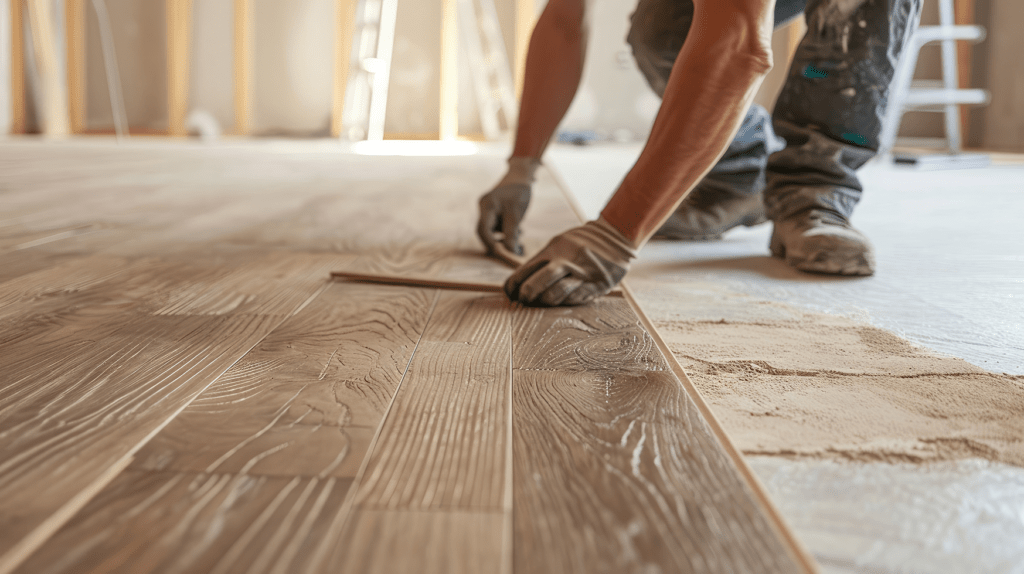When embarking on a home remodel, choosing the right flooring material can significantly affect aesthetics, functionality, and cost. The range of options available today can be overwhelming, but understanding the pros and cons of each type will help you make an informed decision. Let’s explore various flooring materials, particularly hardwood flooring, and the differences between engineered wood, solid wood, and cheaper alternatives like laminate. We’ll also discuss budget-friendly options to ensure you find the perfect fit.
Hardwood Flooring
Hardwood flooring is a timeless choice that adds elegance and warmth to any home. It’s available in two main types: solid hardwood and engineered hardwood. Each has its own set of advantages and considerations.
Solid Hardwood
What It Is?
Solid hardwood consists of planks milled from a single piece of timber. This type of flooring can be sanded and refinished multiple times, which makes it a long-lasting option.
Pros:
- Durability: With proper care, solid hardwood can last for decades.
- Aesthetics: Offers a classic, natural look that adds value to your home.
- Refinishing: Can be sanded and refinished to remove scratches and renew its appearance.
Cons:
- Cost: Generally more expensive than other flooring options.
- Installation: Can be labor intensive, which can add to the overall cost. Once the wood is installed It must be sanded 3 times with 3 levels of sandpaper, stained if the wood will not have a natural finish and have three coats of polyurethane applied. During this portion of your project no one can walk on the floors.
- Moisture Sensitivity: Prone to warping or expanding in high-moisture environments.
Engineered Hardwood
What It Is?
Engineered hardwood consists of a thin layer of real wood on top of a base of high-quality plywood. A higher-quality engineered product will have a thicker layer of real wood, allowing it to be refinished multiple times, while lower-quality options can be so thin that they can never be refinished. This engineered construction makes it more stable and less susceptible to changes in humidity and temperature.
Pros:
- Stability: Less likely to warp or expand, making it suitable for basements and kitchens.
- Cost-effective: Typically less expensive than solid hardwood.
- Easy Installation: Can be installed using a variety of methods, including floating, naildown or glue-down options.
- Once the product is installed, there is no finishing process, so it can be walked on, and work can continue immediately.
Cons:
- Limited Refinishing: Can only be sanded and refinished a limited number of times, if at all due, to the thinner top layer.
- Aesthetics: While it looks similar to solid hardwood, some purists prefer the latter for its feel and authenticity.
Budget-Conscious Flooring
Not everyone has the budget for high-end flooring materials like solid or engineered hardwood. Fortunately, several affordable options don’t compromise on style or durability.
Laminate Flooring
What It Is?
Laminate flooring is made of a composite material that mimics the look of hardwood, stone, or tile. It consists of a photographic layer under a clear protective layer, all bonded to a fiberboard core.
Pros:
- Affordability: One of the most budget-friendly flooring options.
- Durability: Resistant to scratches, dents, and stains.
- Easy Installation: Many laminate floors use a click-and-lock installation method that’s DIY-friendly.
Cons:
- Moisture Sensitivity: Not ideal for areas with high moisture, such as bathrooms.
- Lifespan: Generally doesn’t last as long as hardwood or engineered wood.
- Repairs: Damaged sections can be difficult to replace seamlessly.
Vinyl Flooring
What It Is?
Vinyl flooring is made from synthetic materials like PVC. It’s available in sheets, tiles, or planks and can mimic the appearance of wood, stone, or tile.
Pros:
- Waterproof: Excellent for bathrooms, kitchens, and basements.
- Comfort: Softer underfoot compared to laminate or tile.
- Affordability: Generally less expensive than many other flooring options.
Cons:
- Aesthetics: May not have the same high-end look as natural materials.
- Environmental Impact: Made from non-renewable resources and can emit volatile organic compounds (VOCs).
Tile Flooring
What It Is?
Tile flooring includes ceramic, porcelain, and stone materials. It’s a versatile option that can be used in any room of the house.
Pros:
- Durability: Extremely durable and long-lasting.
- Variety: Available in countless styles, colors, and patterns.
- Water Resistance: Ideal for bathrooms, kitchens, and outdoor spaces.
Cons:
- Cost: High-quality tiles can be expensive, and installation costs can add up.
- Cold and Hard: Can be uncomfortable to stand on for long periods and may require heating in colder climates.
Choosing the right flooring material for your home remodel is a crucial decision that impacts your space’s look and functionality. Whether you opt for the timeless elegance of solid hardwood, the practicality of engineered wood, or the affordability of laminate and vinyl, each option has its benefits and drawbacks. By understanding these pros and cons, you can make an informed choice that aligns with your budget and lifestyle.
For more expert tips and detailed guides on home remodeling, stay tuned to our blog and contact our expert team for a custom consultation on your home.



